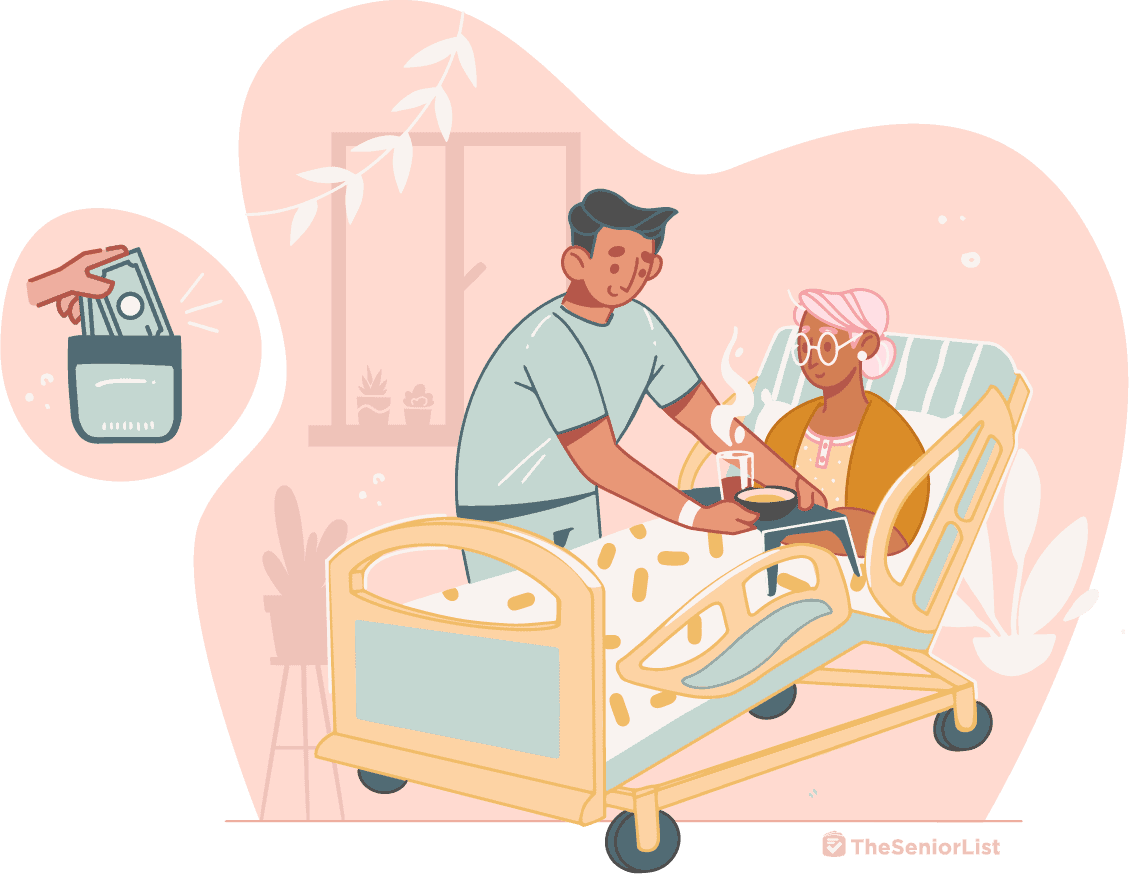Which States Pay Family Caregivers in 2025?
State Funding for Caregivers: Takeaways
- Through various state and federal programs, nearly every state offers some form of pay for family caregivers.
- In my experience, the most common funding sources include Medicaid state plans, employer-paid leave programs, home and community-based services (HCBS), and self-directed programs.
- In many cases, Medicare Advantage plans will offer some type of coverage for professional caregiving services.
FYI: On average, home care costs over $20 per hour. To make sure your loved one is safe, even when you’re not around, consider purchasing a top-rated medical alert system, which costs as low as $19 per month.
Medicaid Programs for Family Caregivers
Unfortunately, not all states provide compensation for family caregivers, and there might be limitations to receiving certain benefits. While the cost of unpaid caregiving is valued at $470 billion, there are still many ways family caregivers can apply for different programs and receive financial assistance for caring for a loved one.
Medicaid State Plans
Family caregivers can receive financial assistance and respite care through certain Medicaid state plans. However, the level of assistance and eligibility for such programs may vary across states, and all involve an application process. The best way to find out if your state has Medicaid benefits for caregivers is to reach out to your local eligibility office directly.
There are some states that may give family caregivers the option of choosing self-directed Medicaid services, which offer more freedom and flexibility regarding care options. A few such options include the Community-Based Services Waiver Program and self-directed personal assistance services state plans.
Home and Community-Based Services
According to Medicaid, HCBS provides Medicaid beneficiaries the flexibility of receiving services in a home or community setting instead of a nursing home or other institution. The programs offer personalized care and assistance to specific groups, such as individuals with disabilities or those who need help with everyday tasks such as bathing and taking medications.
This program does have some limitations and challenges, including the fact that 24/7 assistance may not always be available; further, due to high demand, there may not be adequate numbers of qualified caregivers. To apply for HCBS or other waivers and programs, reach out to your state’s respective Medicaid office.
FYI: If you’re looking to be a caregiver for a loved one, read my guide: How To Get Paid To Be a Caregiver for Parents.
Community First Choice
Community First Choice, or the 1915 (k) state plan option, is a Medicaid program that was created under the Affordable Care Act. This option provides state home and community-based personal attendant services for those eligible for Medicaid state plans. A total of nine states — including California, Montana, Maryland, Oregon, and Texas — have implemented the CFC option in recent years.
According to the American Council on Aging, this program provides both long-term care, as well as the option to apply for self-direction services. The goal of the latter is to help shift the resources and direction away from long-term services to more personalized, home and community-based services. For example, Texas has offered Community First Choice as a state option since 2015.
CFC is available for those who are eligible for Medicaid, require an institutional level of care, and need help with daily living tasks such as bathing, eating, and dressing.
Did You Know: There are many types of caregivers. For instance, family caregivers include a family member or a friend that is willing to step up and care for their loved ones. Read my article on quality in-home care to learn more.
Self-Directed Personal Assistance Services
According to Medicaid, self-directed personal assistance services (PAS) are “personal care and related services provided under the Medicaid state plan or 1915(c) waivers.” Self-directed services usually mean that the individual or representative has authority and personal responsibility for services. They also assume responsibility for all aspects, including training and managing.
Under PAS, individuals are given a budget plan and service plan using a “person-centered and directed process,” according to Medicaid. In terms of limitations, states can usually target those who are already receiving waiver services or limit the number of individuals who choose to self-direct their PAS.
Pro Tip: The key to effective home care is to make sure your space is safe. Read my guide to home modifications for seniors to learn how to prevent falls and other injuries.
Medicaid State-Directed vs. Self-Directed Care
Medicaid currently provides health coverage to over 74.2 million Americans, including low-income adults and children, aging adults, and individuals with disabilities. According to Medicaid, this federal health coverage program is funded by states and the federal government. As a caregiver, you might wonder whether it’s more beneficial to choose between Medicaid state-directed or self-directed care, which gives individuals more of a say in how services are administered, as well as the level of care.
For instance, self-directed care enables the professional or family caregiver to have freedom and control over services. They are in charge of assessing, hiring, evaluating, and determining the level of care required — without a middle man.
On the other hand, Medicaid state-directed care gives more control to state agencies and care organizations. It usually involves services or payments that are handled or overseen by a state agency or health-care organization.
Each type of care has its own benefits, so it’s important to weigh the pros and cons to determine whether you would prefer making decisions over services or would rather have an agency step in and oversee them.
| Medicaid State-Directed Care | Self-Directed Care |
|---|---|
|
|
States That Pay Family Caregivers
Several states offer some form of compensation, benefits, or support to family caregivers under qualifying circumstances and eligibility factors. For instance, California, New Jersey, New York, Washington, Oregon, and Hawaii are a few of the many states that pay family caregivers and provide ongoing caregiving resources and support.
On average, many states with paid family caregiving incentives can provide anywhere from $600 a week to $1,000-plus in family leave support. In particular, California is a standout state when it comes to supporting family caregivers. For instance, the California Paid Family Leave Act provides benefit payments to those who temporarily leave a job to care for a seriously ill loved one.
Additionally, California employees can receive up to 60-70 percent of lost weekly earnings between five to 18 months before the claim start date, according to the Employment Development Department for the State of California. The state also has a unique program known as Family Caregiver Services, which helps coordinate services for respite care as well as in-home or out-of-home assistance. These services are provided to adult family members or informal caregivers who are 18 or older and provide care to individuals who are 60 or older.
Did You Know: Did you know that many states will pay for respite care? To learn more, read my guide: What Is Respite Care?
Other states, like Nebraska, also offer support programs for caregivers such as the Lifespan Respite program, which provides up to $125 per client, per month. The program helps pay for respite services and relieves a family caregiver for a short period. Interesting tidbit: Research has shown that New Jersey is the best state for live-in caregivers — with a median salary of $55,660 (as of 2020), according to this Zippia report.
While most states do offer support for family caregivers, some states have certain restrictions regarding program eligibility. For instance, while Florida offers caregiver support, the state provides certain limitations for self-directed care.
Getting Started
Family caregivers play a vital role in the health and wellness of aging adults and individuals with disabilities. With so many state and federal resources and programs now offering monetary assistance, caregivers have even more options to choose from when it comes to providing quality care. Depending on the state and location, paid family caregiving benefits — along with ongoing support and respite care — can help alleviate a lot of the financial stress many caregivers experience.
To learn more about caregiving, be sure to read my all-purpose guide to caregiving.
State Pay for Caregivers — Frequently Asked Questions
-
Does the government pay for family caregivers?
Through Medicaid and VA benefits, many states pay family members to care for their loved ones; however, restrictions and payment amounts vary greatly by location.
-
Can a family member get paid for taking care of a family member?
In most states, you can receive payment from Medicaid to care for family members; however, this care is often restricted to adult children, although in some cases, it is extended to spouses.
-
Can a wife get paid for taking care of her husband?
Currently, New Jersey, Rhode Island, New York, California, and Washington offer means through which a person can receive payment to care for their spouse.
-
How can I get paid for taking care of someone?
To get paid by the state for care, you can do so through Medicaid, other state programs, or VA benefits. To get started, you’ll want to contact your state’s Medicaid office.


